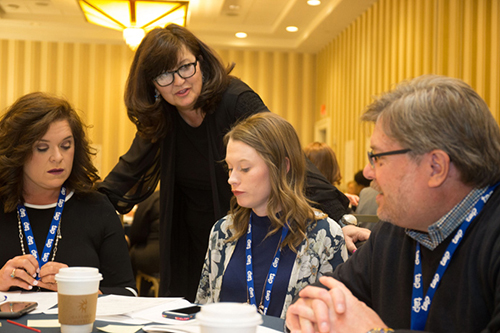How to Lead Effective Professional Learning and Instructional Coaching
December 4, 2018

Natalie Szakacs at an NIET training.
To achieve a year or more of academic growth for all students in high-need schools is a major challenge. Principals know this all too well, and often feel ill-equipped to identify what needs to be changed or how to communicate that change to teachers. Their support feels more like criticism, or is simply not specific or detailed enough to lead to improvements in practice.
Having worked on this challenge and identified key lessons learned to help principals lead instructional improvement, Kendra Johnson, an instructional coach in Athens City Schools, and Tammy Woolbright, principal of Dodson Branch School in Jackson County, joined me to share their experiences at the 2018 Tennessee LEAD Conference this fall.
We were excited that the topic of our session on leading professional learning and providing effective coaching in classrooms was aligned to the message delivered by Tennessee Commissioner of Education Dr. Candice McQueen in her opening remarks at the conference. She called on educators to focus on classroom instruction:
"What happens in the classroom every single day—how engaging our teaching is, how much it pushes students, and how we go about driving learning—is the absolute most important part of what happens in education. We often do not spend enough time reflecting on our practice and how we can improve."
The training we led with principals and teacher leaders later that day focused on specific strategies and techniques for helping teachers to improve their classroom practice through professional learning and classroom coaching.
We started with the question, "How do you know your professional learning for teachers is having an impact that is strong enough to push student learning?"
Principals in our session reported that they believed teaching in their building was aligned to standards, but an analysis of classroom practices revealed that in too many schools, this was not the case.
While each school must create a plan based on its unique needs and challenges, principals and teacher leaders identified several strategies they could adopt. These include:
-
Establish effective weekly collaborative learning in schools—job embedded, led by trained teacher leaders, using research-based strategies. Follow-up with coaching by teacher leaders in individual classrooms.
-
Develop collective leadership through including teacher leaders on school leadership teams that analyze data and drive schoolwide improvement strategies.
-
Build a reflective culture and a common language around effective instruction by using an instructional rubric or teaching standards, and help teachers unpack those standards to understand what they look like in each classroom.
-
Build capacity within schools and districts to establish high expectations and high levels of support for instruction.
What Commissioner McQueen calls "our laser focus on what happens in the classroom" is a key part of the student learning growth Tennessee has achieved over the last five years.
As schools look for strategies to improve classroom teaching, they should consider what Tennessee educators are saying: A focus on improving classroom instruction—including support for reflection on their practice and how it can be improved—is essential to success.